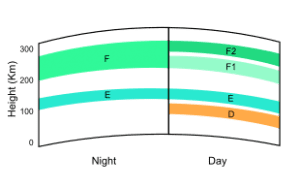Here you can download the free lecture Notes of Antenna and Wave Propagation Notes Pdf – AWP Notes pdf materials with multiple file links to download. Antenna and Wave Propagation Pdf notes book starts with the topics covering Antenna Basics, Thin Linear Wire Antennas, Antenna Arrays: Point Sources, etc.
Antenna and Wave Propagation Notes Pdf – AWP Notes
B.tech Antenna Wave Propagation Notes – AWP notes. Please find the download links below

Please find the Notes below according to the New and Old Syllabus:
Latest Material Links
Complete Notes
1 Unit Notes
2 Unit Notes
3 Unit Notes
4 Unit Notes
5 Unit Notes
Old Material Links
1 Unit – Download Link
2 Unit – Download Link
3 Unit – Download Link
4 Unit – Download Link
5 Unit – Download Link
Complete Notes – Download Link
Old and Lecturer Antenna and Wave Propagation Notes links are below (only 3 units are available)
-
UNIT I Antenna Basics:
Introduction. Basic Antenna Parameters – Patterns, Beam Area, Radiation Intensity. Beam Efficiency, Directivity-Gain-Resolution. Antenna Apertures, Effective Height. Illustrative Problems. Fields from Oscillating Dipole, Field Zones, Shape-Impedance Considerations, Antenna Temperature, Front – to-back Ratio, Antenna Theorems, Radiation- Basic Maxwell’s Equations, Retarded Potentials – Helmholtz Theorem
Unit – 1
-
UNIT II Thin Linear Wire Antennas – Antenna Wave Propagation Notes
Radiation from Small Electric Dipole, Quarter Wave Monopole and Half Wave Dipole – Current Distributions, Field Components, Radiated Power, Radiation Resistance, Beam Width, Directivity, Effective Area and Effective Height, Natural Current Distributions, Far Fields and Patterns of Thin Linear Centre-fed Antennas of Different Lengths, Illustrative Problems. Loop Antennas — Introduction, Small Loop. Comparison of Far Fields of Small Loop and Short Dipole, Radiation Resistances and Directivities of Small and Large Loops (Qualitative Treatment).
Unit – 2 : N/A

-
UNIT III Antenna Arrays: Point Sources
Definition, Patterns, arrays of 2 Isotropic Sources – Different Cases, Principle of Pattern Multiplication, Uniform Linear Arrays – Broadside Arrays, Endfire Arrays, EFA with Increased Directivity. Derivation of their Characteristics and Comparison, BSAs with Non-uniform Amplitude Distributions — General Considerations and Binomial Arrays, Illustrative Problems.
Unit – 3 : N/A
-
UNIT IV VHF. UHF and Microwave Antennas – I : Antenna and Wave Propagation Pdf
Arrays with Parasitic Elements. Yagi-Uda Array. Folded Dipoles and their Characteristics, Helical Antennas – Helical Geometry. Helix Modes. Practical Design Considerations for Monofilar Helical Antenna in Axial and Normal Modes. Horn Antennas -Types, Fermat’s Principle, Optimum Horns. Design Considerations of Pyramidal Horns, Illustrative Problems.
Unit – 4
-
UNIT V VHF, UHF and Microwave Antennas – II: Antenna and Wave Propagation Pdf
Microstrip Antennas ~- Introduction. Features, Advantages and Limitations. Rectangular Patch Antennas — Geometry and Parameters, Characteristics of Microstrip Antennas. Impact of Different Parameters on Characteristics, Reflector Antennas — Introduction, Flar Sheet and Corner Reflectors, Paraholoidal Reflectors — Geometry. Pattern Characteristics, Feed Methods. Reflector Types – Related Features. Illustrative Problems.
Unit – 5
-
UNIT VI Lens Antennas – Antenna and Wave Propagation Notes Pdf
Introduction, Geometry of Non–metallic Dielectric Lenses, Zoning, Tolerances, Applications. Antenna Measurements: Introduction. Concepts – Reciprocity, Near and Far Fields, Coordinate System, Sources of Errors. Patterns to be Measured, Pattern Measurement Arrangement, Directivity Measurement. Gain Measurements (by Comparison, Absolute and 3-Antenna Methods)
Unit – 6 : N/A
-
UNIT VII Wave Propagation – I: Antenna and Wave Propagation Notes Pdf
Introduction, Definitions, Categorizations and General Classifications, Different Modes of Wave Propagation, Ray/Mode Concepts. Ground Wave Propagation (Qualitative Treatment) — introduction, Platte Earth Reflections, Space and Surface Waves, Wave Tilt, Curved Earth Reflections. Space Wave Propagation – Introduction. Field Strength Variation with Distance and Height, Effect of Earth‘s Curvature. Absorption. Super Refraction. M-Curves and Duct Propagation. Scattering Phenomena. Tropospheric Propagation, Fading and Path Loss Calculations.
Unit – 7 : N/A
-
UNIT VIII Wave Propagation – II: Antenna and wave propagation pdf
Sky Wave Propagation — Introduction. Structure of ionosphere, Refraction and Reflection of Sky Waves by ionosphere, Ray Path, Critical Frequency, MUF, LUF, OF, Virtual Hlght and Skip Distance. Relation between and Skip Distance, Multi-hop Propagation. Energy Loss in ionosphere. Summary of Wave Characteristics in Different Frequency Ranges.
Unit – 8 : N/A
FAQs
Q1: What is antenna pattern?
A1: It is a graphical representation which represents the radiation properties of antenna (as a function of space). Pattern in graphical representation explains the the process of energy radiation of antenna out into space. It also explains how antenna receives energy. It is also called radiation pattern.
Q2: What is Radiation intensity?
A2: The power radiated from an Antenna per unit solid angle is called the Radiation Intensity.
Q3: What is Ionosphere?
A3: It is a part of earth atmosphere, from about 85 km to 600 km altitude. It comprises portions of the thermosphere, mesosphere, and exosphere. Ionosphere is distinguished by Exosphere and thermosphere since it is ionized by solar radiation.
Here is how ionospheric layers look like,

- TEXT BOOKS : 1. Antennas for All Applications – John D. Kraus and Ronald J. Marhefka, TMHl, 3rd Edn. , 2003. 2. Electromagnetic Waves and Radiating Systems – E.C. Jordan and K.G. Balmain, PHI, 2nd ed., 2000.
Note :- These notes are according to the r09 Syllabus book of JNTUH. In R13 ,8-units of R09 syllabus are combined into 5-units in r13 syllabus. Click here to check all the JNTU Syllabus books
